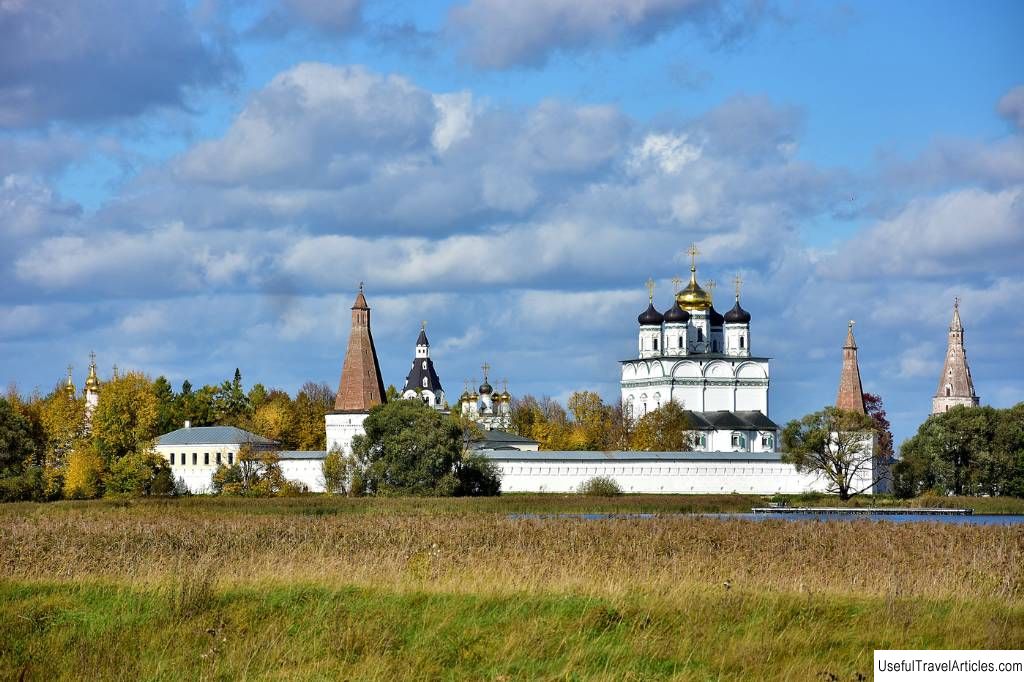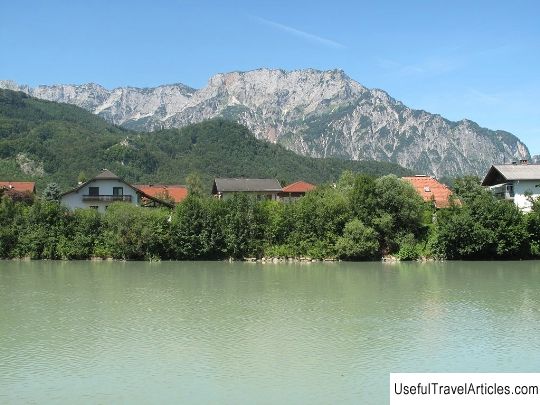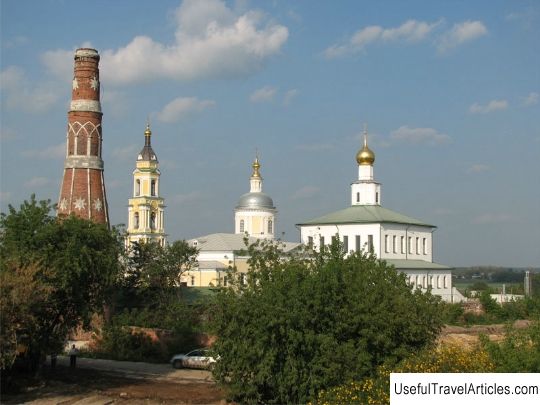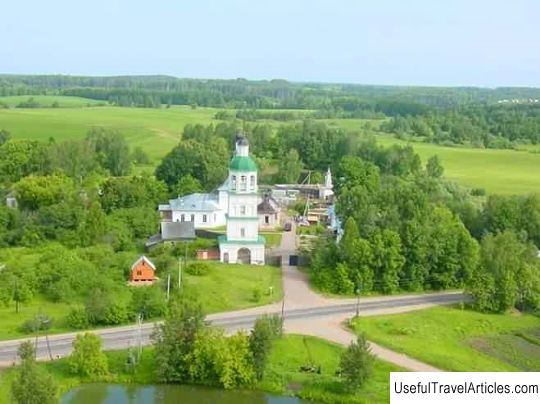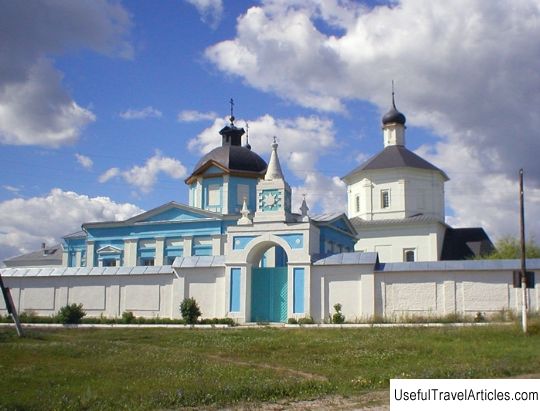Iosifo-Volotskiy Monastery description and photos - Russia - Moscow region: Volokolamskiy district
Iosifo-Volotskiy monastery description and photos - Russia - Moscow region: Volokolamskiy district. Detailed information about the attraction. Description, photos and a map showing the nearest significant objects. Photo and descriptionIosifo-Volotskiy monastery near Volokolamsk is one of the most picturesque places in the Moscow region. This is both an Orthodox shrine and a powerful fortress of the 17th century, with white stone walls decorated with tiles and brick patterns. Now it is a functioning monastery, on the territory of which a unique Bible museum is located. Joseph Volotskiy - the founder of the monasterySaint Joseph Volotskiy lived in the late 14th - early 15th centuries. For 18 years he was a monk of the monastery in Borovsk and the closest student of St. Pafnutia Borovsky . After his death, he was appointed abbot, but the monks did not accept him - and then he left to found his own monastery near Volokolamsk. Joseph himself was from the Volotsk noble family of the Sanins , their ancestral estates were located there. For a long time Joseph had friendly relations with the son of the Moscow prince Vasily the Dark Boris, who was the Volotsk prince during those years. 1479 is considered the year of the foundation of the monastery. Funds for it were allocated by Prince Boris . In those years, a dense forest grew here, but legend says that a terrible storm cleared the place for the monastery. At first, the monastery consisted of several wooden cells and a small church near the spring, but already in 1486 a stone Cathedral in honor of the Assumption of the Virgin was built. It is painted by the famous Dionysius . Joseph himself compiles the charter for the monastery. The charter is "communal", that is, all the property of the brethren is considered common and all are equal to each other. Joseph Volotsky was a writer and theologian. He defended the right of the Church to have earthly riches. He and his followers, the " Josephites ", argued with the movement of the so-called "non-possessors", who believed that a monk should think exclusively of God, and not do the housework. Joseph thought that the church should be strong, that its mission is preaching and charity, and without money it is impossible to carry out active good. This problem is still being debated. One way or another, his monastery and the monasteries founded by his students were rich, reasonably organized, and could help the surrounding residents: they treated, fed in hungry years and gave them the opportunity to earn money. He also cared about preaching - he owns the opinion that heretics who embarrass the people should be persecuted by the state. Joseph died in 1515, and already in 1579 he was canonized. Famous prisoners Under Joseph, the monastery is growing rapidly. The Volotsk prince and princess donate the surrounding lands to him. In the monastery itself a book correspondence workshop starts up. In the middle of the 16th century, stone construction continued actively. A wall with nine towers is being erected here: the monastery becomes one of the most powerful fortresses protecting Russian lands from the northwest. After the canonization of the founder, pilgrims flow here, and the fortifications begin to be used as a place of imprisonment for state criminals and heretics - you cannot escape from here. Here sat the famous non-possessor Vassian the Kosoy , who at one time argued with Joseph, and eventually died in captivity in his monastery. Another non-possessor was serving a harsh sentence here, "The first Russian intellectual" - Maxim Grek . Now both the one and the other are canonized and revered in the monastery on a par with the founder. During the Time of Troubles, the monastery fortress takes an active part in hostilities. The monastery is supported by Vasily Shuisky , and in 1606 it was besieged by the troops of Ivan Bolotnikov who rebelled against him. But this time it was not possible to take the fortress. But four years later it was occupied by the Polish detachment of Hetman Rozhinsky . Artillery from Tushino is being transported here. But in 1610, the Russian-German-French troops knocked the Poles out of the monastery. Some of the guns remain in the monastery in memory of the liberation. And then Vasily Shuisky himself is imprisoned here. He was overthrown and forcibly tonsured into a monk. The former tsar spends some time in the Joseph-Volotsky Monastery until he is taken to Poland. During the fighting, the monastery was badly damaged, so in the middle of the 17th century a grandiose construction began here. Almost the entire modern complex of the monastery was built at that time. Walls and towers New fortress walls are being erected by master Trofim Ignatiev . These are powerful walls with three rows of loopholes. The main fortifications are located in the northwest: Lithuania and Poland are still considered the main opponents. The attack is expected from there. All towers are made different - they have from eight to twenty-four faces. Two towers had stone ends, the rest are wooden (they were replaced by stone ones already in the 18th century). The tallest tower, Kuznechnaya, is forty-four meters high. Its walls are two and a half meters thick. The stairs inside the towers could get into the passage inside the wall between the narrow loopholes and fire at the enemy. But the walls and towers were not only of strategic importance. The snow-white towers with tiled patterns were also beautiful and still amaze the imagination. Each tower has its own unique decorations and patterns. Cathedral of the AssumptionThe building that has survived to this day is 1692 built. This is an example of classical Moscow architecture of the 17th century: a majestic five-domed temple, decorated with belts of tiles, carved half-columns, architraves and cornices. The temple has large windows for this time, so it was always light inside. The iconostasis was also carved. Some of the icons from its oldest part have survived to our time and are now in the Museum. Rublev in Moscow. The murals of the temple have changed significantly over time. The last time it was painted in 1904 by the Palekh painter N. Safonov . The same artel will later paint the Faceted Chamber in Moscow. The lower temple of the monastery was rebuilt in the 18th century from the burial vault of the Volokolamsk princes and monastic abbots. A church dedicated to Joseph Volotsky himself was built here, and his relics are now located here. Nearby was a stone bell tower with a chime clock. In the middle of the 19th century, it began to tilt and it took a long time to strengthen and rebuild. But the bell tower has not survived to this day - it was blown up in 1941. In addition to the main cathedral, the monastery has an interesting refectory , built on the model of the Moscow Faceted Chamber around one pillar, the rector's corps and the treasurer's corps . In 1679, an elegant gateway church of Peter and Paul was built over the holy gates . XX-XXI centuries After the revolution, this monastery, like many others, was turned into a “ labor commune ”. All the same monks lived here, and the abbot became the chairman. In 1922 the commune was also liquidated. The monastery became a children's home , a cinema was set up in the cathedral, and the main values were sold to the capital's museums. In 1941, battles broke out around the fortress again. The front line passed along the Volokolamsk direction: Soviet troops, stubbornly resisting, retreated. When retreating from the monastery, the bell tower was blown up - after all, Moscow was visible from it. In the fall of 1941, the territory of the monastery was occupied by the Germans, and in the winter of 1941 it was liberated again. After the war, the orphanage returned here. The monastery was returned to the Church in 1988. The relics of St. Joseph . With the blessing of the abbot, a scientific study of the body was carried out. The approximate date of death was confirmed and even a disease was diagnosed, which gave the picture that is described in the life: weakness, exhaustion and severe headaches. Since 2001 cancer with relics exhibited in the lower church of the cathedral for worship. In 2004, the monastery was officially handed over from the museum to the chains of St. Joseph, now they are also exhibited in the Assumption Cathedral. In 2009, a monument to St. Joseph by the sculptor S. Isakov. One of the shrines of the monastery is the Volokolamsk Icon of the Mother of God . This is an exact copy of the Vladimir Icon, according to legend, made in 1572 by order and vow of a certain nobleman. This nobleman is Grigory Belsky , better known to us as the famous Malyuta Skuratov , the guardsman and associate of Ivan the Terrible. The monastery believes that before his death, Malyuta repented of all his crimes, and the icon he donated immediately began to work miracles. Now the icon itself is in the Museum. AND. Rublev in Moscow, and the monastery honors her exact list. Malyuta Skuratov-Belsky was generally closely associated with this monastery. His father and one of the brothers were monks here, and here he was buried. Tsar Ivan the Terrible and Malyuta's relatives gave rich donations to the monastery for commemorating his soul. Bible Museum Now the monastery houses a unique museum - the Museum of the Bible. This is a continuation of traditions, because once there was a workshop for rewriting books and a huge monastery library. In the museum you can see unique books : the Bible from 1581, the richly engraved Elizabethan Bible from 1751, modern bibles in various editions. The oldest book in the museum is the French Bible of 1568 . The museum occupies three halls in total. A separate exposition is dedicated to the Volokolamsk Metropolitan Pitirim - the first abbot of the revived monastery. Not far from the monastery there is a skete of All Saints . It was founded in 1855 on the site of the very first cell of St. Joseph and the source he once found. The building of the almshouse of 1903 has been preserved there - in Soviet times there was a hospital in the skete. Now the hermitage is being revived. Interesting factsIn 2013, a commemorative coin of 25 rubles with the silhouette of the monastery was minted. It was here that the battle scenes of the film "War and world "based on the novel by L. Tolstoy, director S. Bondarchuk. The population of the surrounding villages was employed as extras. The monastery now has a commemorative plaque dedicated to these filming. The monastery is now baking its own bread and producing its own dairy products. Notes
     We also recommend reading House-Museum of German colonists description and photo - Ukraine: Zaporozhye Topic: Iosifo-Volotskiy Monastery description and photos - Russia - Moscow region: Volokolamskiy district. |
